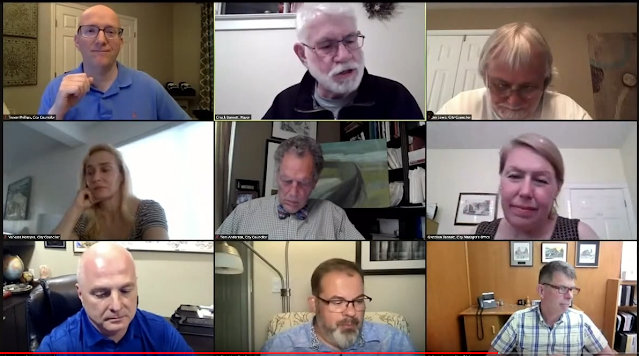Wednesday, July 21, 2021
7/20/21 Minutes
Wednesday, July 7, 2021
CANDO FY 2020/2021 Finance Statement
Note: the total Zoom expense for the fiscal year (July thru June) was $179.88. The balance at the end of the 2020/2021 fiscal year should be shown as $195.24. See below.
Friday, July 2, 2021
News from the Continuum
By Sarah Owens and Michael Livingston
 |
| 1185 22d Street selected as site for low-barrier shelter/nav center |
City staff surprised no one at Monday night's Council meeting by announcing that the plan to site a temporary low-barrier shelter/nav center in the old Men's Mission building at 345 Commercial Street NE (soon to be vacated) was not going to work. Its main attraction was the fact that the City owns the building. This means that Salem will have to wait for rehab/improvements to the permanent low-barrier shelter/nav center site on 22d Street before starting to spend the $5M operations funding that the state legislature appropriated for that purpose in April (SB 5042, signed into law on April 15, 2021).
Jimmy Jones, executive director of the Mid-Willamette Valley Community Action Agency (whose ARCHES Project will operate the new nav center), told City Council he hoped to open the facility by winter. Winter begins 21 December 2021, and Mr. Jones is a self-professed optimist. The City has budgeted $3M of City ARPA funds for the purchase ($2.75M)/rehab of the 22d Street site. But, the City has not as yet identified a funding source for the $1.5M/yr cost to operate the facility 24/7 after the state funding runs out, as shown in the Budget Committee slide, below.
Listening to Council Monday night, you'd be forgiven for thinking that this new program was Council's long-held dream come true, but for as long as Chuck Bennett's been mayor, the top of the homeless response wish list has been a sit-lie ordinance and a sobering center, though neither is considered part of the the continuum of care for people experiencing homelessness, much less a "best practice." There was no navigation center in the City's initial Strategic Plan (2017) -- the City adopted it only after the State identified the need and signaled in the 2020 short session that it was prepared to fund it. See Oregon Statewide Shelter Study (Aug 2019) and "Council Sets Ambitious 2020 Policy Agenda"
(14 February 2020). No one should think for a minute that Mayor Bennett's changed his thinking as to what's "really" needed downtown.
 |
| 28 June 2021 City Council Meeting |
In addition to funding the City nav center's operations, the 2021 Session of the Oregon legislature secured for persons experiencing homelessness no-fee DMV IDs (HB 3026), 72-hour written notice of intent to clear an established camp site (HB 3124), and the right to challenge to local laws regulating sitting, lying, sleeping or keeping warm and dry outdoors on public property open to public* (HB 3115) (see "City Opposes State Limits on Sit-Lie, Camping Bans" (19 March 2021) and Harrell, S. "Salem area officials worry bill to decriminalize homelessness will just lead to more litigation." (14 April 2021, Salem Reporter.)).
The legislature also infused funds into the Yaquina Hall project (HB 5002) (see "SHA to Develop Yaquina Hall" (23 March 2016)) (updated) and told the medical examiner to report "domicile unknown" when issuing the death certificate of homeless persons (SB 850). See Zuhl, J. "Multnomah County tracks homeless deaths. Now, other counties might too." (7 April 2021, StreetRoots.); Whitworth, W. "'All of them had a name:' No one knows for sure how many people are dying while homeless in Oregon." (4 April 2021, Statesman Journal.)
The much-touted HB 2417 -- which a City staff report described as allowing local governments to establish "a new mobile crisis response system to meet those in mental health crisis where they are" as well as "new (or support an existing) sobering center" -- failed to pass as originally drafted. The original bill was gutted and stuffed with another bill intended to get OHA to study, coordinate and expand access to (in that order) statewide crisis services, including a 9-8-8 suicide prevention hotline. See HB 3069. Makes sense to study and coordinate first, at the state level, and avoid the creation of 36 (counties) + 1 (state) separate crisis response systems, criteria, etc., but the setback will, no doubt, disappoint the Salem Budget Committee, which, at Councilor Nordyke's urging, included a 25% match for a CAHOOTS-style mobile unit in the recommended budget for FY 2022. HB 2417 did allocate $10M to counties for their mobile crisis response units, which in Marion and Polk include the dreaded law enforcement component. Funding for a mobile crisis unit and sobering center was in Council's 2020 Policy Agenda. See "Council Sets Ambitious 2020 Policy Agenda" (14 February 2020). The mobile crisis unit made it into Council's 2021 Homeless Policy Agenda (sort of), but the sobering center -- rightly -- did not. See "Council's 2021 Homeless Policy Agenda" (19 January 2021).
* The Oregonian headline writer had a different interpretation. See Hayden, N. "Oregon will allow homeless individuals to sleep on public land in all communities." (9 June 2021, Oregonian/OregonLive.)
9/23/21 Update: Tabrizian, A. "Salem, United Way halt plans for mental health crisis responder program." ( 23 September 2021, Salem Reporter.) Not that it would have made any difference, but Nordyke didn't even talk to the commissioners.




